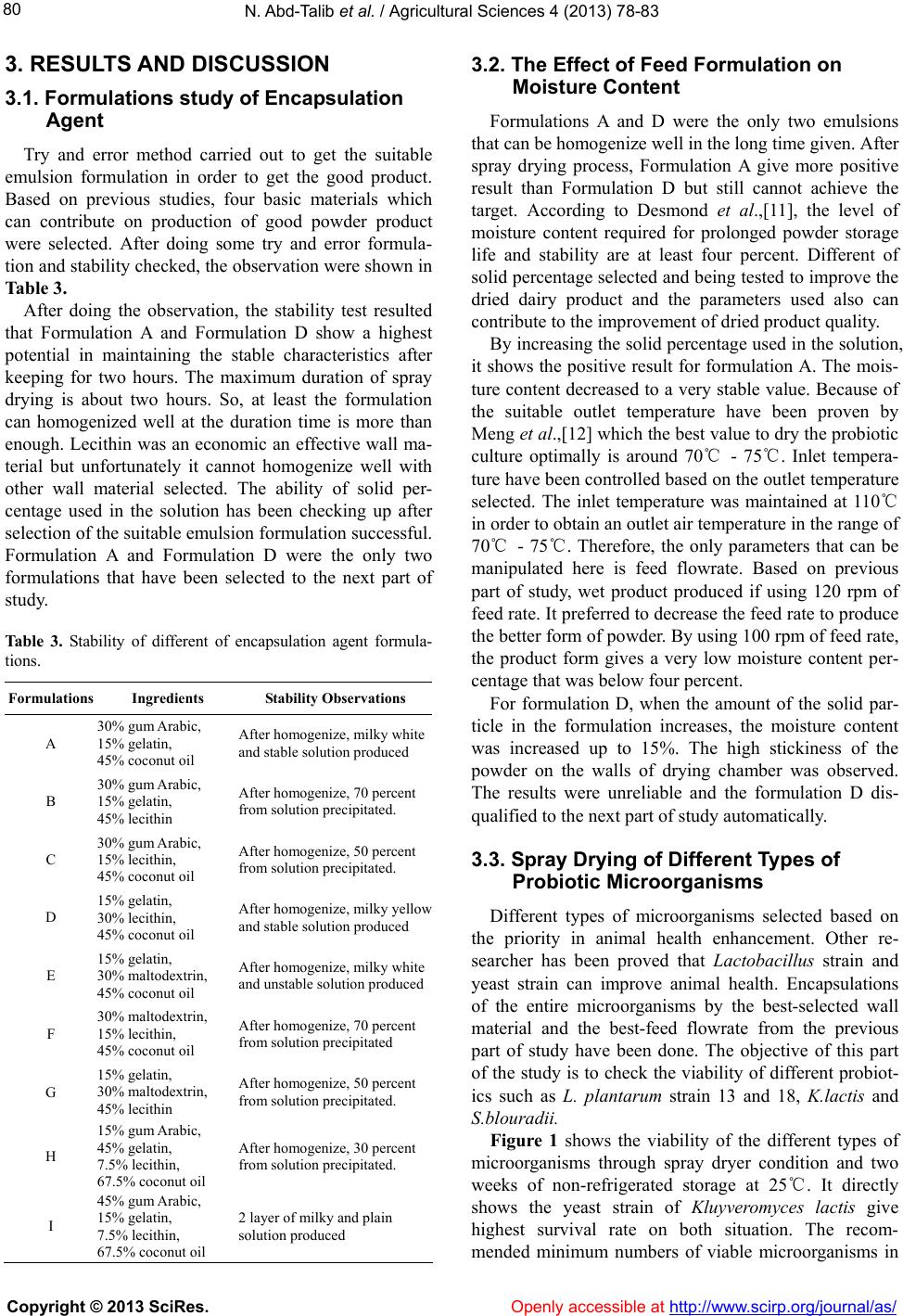
N. Abd-Ta lib et al. / Agricultural Sciences 4 (2013) 78-83
80
3. RESULTS AND DISCUSSION
3.1. Formulations study of Encapsulation
Agent
Try and error method carried out to get the suitable
emulsion formulation in order to get the good product.
Based on previous studies, four basic materials which
can contribute on production of good powder product
were selected. After doing some try and error formula-
tion and stability checked, the observ ation were shown in
Table 3.
After doing the observation, the stability test resulted
that Formulation A and Formulation D show a highest
potential in maintaining the stable characteristics after
keeping for two hours. The maximum duration of spray
drying is about two hours. So, at least the formulation
can homogenized well at the duration time is more than
enough. Lecithin was an economic an effective wall ma-
terial but unfortunately it cannot homogenize well with
other wall material selected. The ability of solid per-
centage used in the solution has been checking up after
selection of the suitable emulsion formulation successful.
Formulation A and Formulation D were the only two
formulations that have been selected to the next part of
study.
Table 3. Stability of different of encapsulation agent formula-
tions.
Formulations Ingredients Stability Observations
A 30% gum Arabic,
15% gelatin,
45% coconut oil
After homogenize, milky whit e
and stable solution produced
B 30% gum Arabic,
15% gelatin,
45% lecithin
After homogenize, 70 percent
from solution precipitated.
C 30% gum Arabic,
15% lecithin,
45% coconut oil
After homogenize, 50 percent
from solution precipitated.
D 15% gelatin,
30% lecithin,
45% coconut oil
After homogenize, m ilk y y ell ow
and stable solution produced
E 15% gelatin,
30% maltodextrin,
45% coconut oil
After homogenize, milky whit e
and unstable solution produced
F 30% maltodextrin,
15% lecithin,
45% coconut oil
After homogenize, 70 percent
from solution precipitated
G 15% gelatin,
30% maltodextrin,
45% lecithin
After homogenize, 50 percent
from solution precipitated.
H
15% gum Arabic,
45% gelatin,
7.5% lecithin,
67.5% coconut oil
After homogenize, 30 percent
from solution precipitated.
I
45% gum Arabic,
15% gelatin,
7.5% lecithin,
67.5% coconut oil
2 layer of milky a n d p l a i n
solution produced
3.2. The Effect of Feed Formulation on
Moisture Content
Formulations A and D were the only two emulsions
that can be homogenize well in the long time given. After
spray drying process, Formulation A give more positive
result than Formulation D but still cannot achieve the
target. According to Desmond et al.,[11], the level of
moisture content required for prolonged powder storage
life and stability are at least four percent. Different of
solid percentage selected and being tested to impro ve the
dried dairy product and the parameters used also can
contribute to the improvement of dried product quality.
By increasing the solid percentage used in the solu tion,
it shows the positive result for formulation A. The mois-
ture content decreased to a very stable value. Because of
the suitable outlet temperature have been proven by
Meng et al.,[12] which the best value to dry the probiotic
culture optimally is around 70℃ - 75℃. Inlet tempera-
ture have been controlled based on the outlet temperature
selected. The inlet temperature was maintained at 110℃
in order to obtain an outlet air temperature in the range of
70℃ - 75℃. Therefore, the only parameters that can be
manipulated here is feed flowrate. Based on previous
part of study, wet product produced if using 120 rpm of
feed rate. It preferred to decrease the feed rate to produce
the better form of powder. By using 100 rpm of feed rate,
the product form gives a very low moisture content per-
centage that was below four percent.
For formulation D, when the amount of the solid par-
ticle in the formulation increases, the moisture content
was increased up to 15%. The high stickiness of the
powder on the walls of drying chamber was observed.
The results were unreliable and the formulation D dis-
qualified to the n ext part of study automatically.
3.3. Spray Drying of Different Types of
Probiotic Microorganisms
Different types of microorganisms selected based on
the priority in animal health enhancement. Other re-
searcher has been proved that Lactobacillus strain and
yeast strain can improve animal health. Encapsulations
of the entire microorganisms by the best-selected wall
material and the best-feed flowrate from the previous
part of study have been done. The objective of this part
of the study is to check the viability of different probiot-
ics such as L. plantarum strain 13 and 18, K.lactis and
S.blouradii.
Figure 1 shows the viability of the different types of
microorganisms through spray dryer condition and two
weeks of non-refrigerated storage at 25℃. It directly
shows the yeast strain of Kluyveromyces lactis give
highest survival rate on both situation. The recom-
mended minimum numbers of viable microorganisms in
Copyright © 2013 SciRes. Openly accessible at http://www.scirp.org/journal/as/